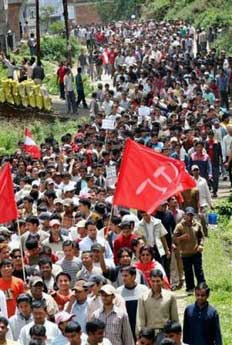Nepal king besieged by strikes, protests
By
David Hoskins
Published Apr 20, 2006 8:07 PM
April 18—Fresh rounds of demonstrations have rocked
Nepal’s capital, Katmandu, during the second week of a general strike.
Tens of thousands of protesters answered the call of opposition parties and
communist revolutionaries in defiance of the government’s shoot-to-kill
orders. Demon stra tors have been demanding since April 6 that the king step
down and hand over power to an all-party government that would call elections to
a constituent assembly.
|
Katmandu, Nepal, April 20.
|
On April 15, protests broke out for the first
time in the heart of Katmandu’s commercial and tourist center, where a
strict ban on protests is in place. In a sign that clear lines are being drawn
in the struggle between popular forces and Nepal’s absolute monarch, the
alliance of opposition parties joined the Communist Party of Nepal (Maoist)
(CPN[M]) in its campaign to encourage individuals and businesses to withhold all
taxes and utility payments from the government.
Professional groups and
civil servants have joined demonstrators in protest of the autocratic monarchy.
Dozens of lawyers were wounded when police opened fire at a rally called by the
Nepal Bar Associ ation. Two more civilians were shot dead by police, bringing
the total number of protesters murdered by government forces to six.
The
harassment of opposition leaders has also continued with the arrest of Sunil
Manandhar, president of the Nepal Pro gressive Trade Union Federation. Thou
sands of opposition leaders, human rights activists and journalists have been
extra-judicially arrested since the start of protests.
Nepal’s
monarch, King Gyanendra, remained in the resort town of Pokhara for much of the
protests. He returned to the capital in mid April to reissue his call for
parliamentary elections that have already been rejected by the revolutionary
forces and opposition parties. Many analysts have concluded that the protests
have grown to a point that even seemingly substantive concessions from Gyanendra
may not halt the anti-king momentum.
Masses in neighboring India
support growing People’s War
Nepal’s general strike is in
part the culmination of 10 years of revolutionary strug gle waged by the CPN(M)
to establish a secular socialist republic. The CPN(M) has close ties to
revolutionaries in northern India led by the Communist Party of India (Maoist).
The party was formed in 2004 by groups associated with years of armed struggle
that began after a peasant rebellion stormed the town of Naxalbari in the Indian
state of West Bengal 38 years ago.
In recent years the revolutionary
struggle in northern India has caught the attention of media and government
officials in the United States. A daring jailbreak on the 88th anniversary of
the Bolshevik Revolution made headlines around the world. On Nov. 13, 2005, over
1,000 fighters of the People’s Liberation Guerrilla Army (PLGA) overran a
prison in the northern state of Bihar, liberating 300 political prisoners. This
new sign of
strength sent shockwaves through the state
forces.
Government-sponsored militias have orchestrated a campaign of
terror against civilians suspected of supporting the PLGA. Vigilante groups such
as the Salwa Judum have been explicit about the tactics they employ. As Mahendra
Karma, a prominent supporter of Salwa Judum, boastfully stated, “Unless
you cut off the source of disease, the disease remains. The source is the
people, the villagers.”
As in Nepal, India’s revolution is
fueled by a rigid caste system that creates glaring inequality and poverty.
More than half of Indian women are denied the right to read and write and over
25 percent of the population lives in extreme poverty. The infant mortality rate
exceeds 54 deaths per 1,000 live births.
Articles copyright 1995-2012 Workers World.
Verbatim copying and distribution of this entire article is permitted in any medium without royalty provided this notice is preserved.
Workers World, 55 W. 17 St., NY, NY 10011
Email:
[email protected]
Subscribe
[email protected]
Support independent news
DONATE


